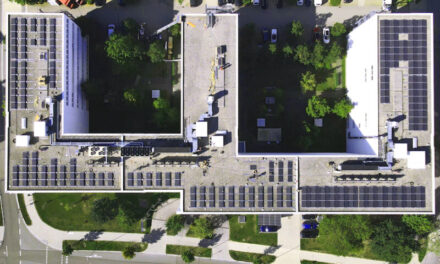 Everyone is aware that simple ventilation can provide a perfectly satisfactory solution to cooling many industrial and commercial premises. However, recent advances in fan technology, controls and evaporative cooling have now taken this principle to a new level of performance.
Everyone is aware that simple ventilation can provide a perfectly satisfactory solution to cooling many industrial and commercial premises. However, recent advances in fan technology, controls and evaporative cooling have now taken this principle to a new level of performance.
Electrically commutated fans
At the heart of any ventilation system is the fan. For both room temperature management and efficiency, fan speed control is essential. This is also demanded by local regulations and European Energy Directives. Traditional fans have induction motors typically controlled using variable frequency inverters or voltage control. This approach has now been replaced with Electronically Commutated (EC) fans which have significant advantages over the traditional AC fans. An EC fan uses both AC and DC voltages. AC is supplied directly to the fan motor and internal electronics convert this to DC to power a fixed magnet DC motor. This provides a very efficient motor with very precise speed control. An EC fan will approximately follow a cube rule for energy consumption which means running an EC fan at half speed uses only 12.5% of the full speed power. In addition to this, capital cost and complexity is reduced relative to AC fans through avoidance of external speed controllers.
Direct evaporative cooling
For many buildings ventilation can service all of the cooling needs for over 90% of the time. In warm weather a refrigeration based cooling system is often used to reduce internal temperatures. This is both expensive to install and to operate. In many applications the refrigeration element can now be replaced by direct evaporative cooling, where the hot air is passed over simple wetted filters and the air is cooled by evaporation. Evaporative cooling supplements the ventilation system providing cool air only when the outside temperature goes above a given set point. In the UK this process can provide a supply air temperature below 20°C for 99% of the time and never go above 24°C. Direct evaporative cooling normally operates at 10% of the energy use of a split air conditioner. Modern direct evaporative coolers have integrated water control systems to maintain hygienic and efficient operation which complies with or exceeds all legionella regulations.
Programmable controllers
A new generation of low cost Programmable Logic Controllers (PLC’s) are now available which provide a simple method to manage ventilation systems. The controller typically takes inputs from temperature, relative humidity and carbon dioxide sensors and produces control signals to operate fans, dampers and control valves using internal logic. Inputs and outputs are either digital (on/off), analogue (variable) or instructions sent over a network. These controllers will communicate with all the components of a ventilation system to optimise heating, cooling and fan energy use. Some PLC manufacturers provide open licence software for the user to develop their own solutions using simple logic programming tools.
PLC’s can operate in isolation or as part of a network. Whilst network protocols can be complex the modern PLC can communicate using Modbus or TCP/IP based systems. This allows completely integrated solutions for building management. A further opportunity exists with the availability of affordable touch screens or Human Machine Interfaces (HMIs). These provide a straightforward solution to providing the end user with set point management, data and event logging and mimics together with email notification. Many HMIs also incorporate remote access with the ability to view and control the ventilation system remotely.
Some examples of how these technologies are applied in different sectors shall now be explained:
Computer room cooling
All IT equipment in server rooms and data centres requires cooling. A ventilation system supplemented with direct evaporative cooling can reduce the cooling energy bill by over 95%. Because there is normally extra cooling capacity for redundancy the fans run at slow speed which further reduces costs. Master and Slave PLC arrangements also provide a resilient solution to cooling. Direct evaporative cooling is only employed for <10% of the time. HMIs and PLCs can be remotely monitored and programmed for commissioning and day to day support.
Pharmaceutical warehouse cooling
Many locations can maintain MHRA compliant conditions by using only ‘free cooling’ (fresh air). Multiple EC fans can be connected directly to simple temperature controllers giving the simplest of automated solutions. PLCs can be used where more stringent conditions have to be met or when heating and cooling systems need to be integrated. Data capture can be extended to provide Mean Kinetic Temperature analysis which can be used in demonstration of compliance.
In conclusion
Ventilation coupled with evaporative cooling and modern controls can provide industrial and commercial premises with a sophisticated air handling system that can compare with any air cooling refrigeration system at a fraction of the energy cost and provide a high level of control of the environment.
For more details, email: Sales@ecocooling.org, visit www.ecocooling.org, follow on Twitter: @ecocoooling1 or call 01284810586



